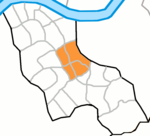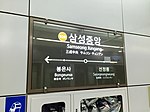Seolleung station
1982 establishments in South KoreaMetro stations in Gangnam DistrictPages with no open date in Infobox stationRailway stations opened in 1982Seoul Metropolitan Subway stations ... and 1 more
Seoul metro station stubs

Seolleung Station is a Seoul Subway station that serves Line 2 and the Bundang Line. The station is named after the nearby Seonjeongneung, Joseon Dynasty royal tombs Seolleung (선릉, 宣陵) and Jeongneung (정릉, 靖陵). On Line 2, the preceding and following stations are Yeoksam Station and Samseong Station. On the Bundang Line these are Seonjeongneung Station, which connects with Line 9, and Hanti Station.
Excerpt from the Wikipedia article Seolleung station (License: CC BY-SA 3.0, Authors, Images).Seolleung station
Teheran-ro, Seoul Yeoksam 2(i)-dong
Geographical coordinates (GPS) Address External links Nearby Places Show on map
Geographical coordinates (GPS)
| Latitude | Longitude |
|---|---|
| N 37.50445 ° | E 127.04898611111 ° |
Address
선릉
Teheran-ro 340
06212 Seoul, Yeoksam 2(i)-dong
South Korea
Open on Google Maps





